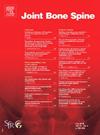非特异性慢性腰痛功能恢复计划后的长期结果:一项10年的纵向研究。
IF 3.8
3区 医学
Q1 RHEUMATOLOGY
引用次数: 0
摘要
背景:关于非特异性慢性腰痛(NSCLBP)患者功能恢复后的长期演变的数据缺乏。因此,这项纵向研究调查了参与功能恢复计划10年内NSCLBP患者的总体改善情况以及其他社会人口学和临床参数。方法:2009 - 2011年在法国某大学医院进行功能修复。在纳入、项目结束、3个月、12个月和10年对患者进行评估。该研究的主要结果是功能恢复后10年的总体改善。有多个次要结局(例如,魁北克背痛残疾量表[QBPDS]和重返工作岗位)。使用广义估计方程评估随时间的变化。结果:研究纳入51例患者(平均[SD]年龄45.6[8.3]岁;54.9%的女性;职工占66.7%;以及66.7%的全职或兼职工作残疾)。10年后总体改善的百分比为76.5%(项目结束时为92.0%;p值不显著)。QBPDS评分从纳入时的平均43.2分提高到10年后的32.2分(p值< 0.001)。最后,超过一半的工作障碍患者在3个月(62.5%)和10年后(60.0%)恢复工作,并且随着时间的推移,这种恢复是稳定的(p值不显著)。结论:NSCLBP患者在功能恢复后10年内预后良好。需要进一步的数据来证实目前的调查结果。本文章由计算机程序翻译,如有差异,请以英文原文为准。
Long-term outcomes after a functional restoration program for non-specific chronic low back pain: A 10-year longitudinal study
Background
There is a scarcity of data on the long-term evolution of patients after functional restoration for non-specific chronic low back pain (NSCLBP). Therefore, this longitudinal study investigated overall improvement and other sociodemographic and clinical parameters in patients with NSCLBP within 10 years of participating in a functional restoration program.
Methods
Functional restoration was undergone in a French university hospital between 2009 and 2011. Patients were evaluated at the inclusion, the end of the program, three months, 12 months, and 10 years. The primary outcome of the study was the overall improvement in the 10 years following functional restoration. There were multiple secondary outcomes (e.g., the Quebec Back Pain Disability Scale [QBPDS] and return to work). Changes over time were assessed using generalized estimating equations.
Results
The study included 51 patients (mean [SD] age 45.6 [8.3] years; 54.9% women; 66.7% employees or workers; and 66.7% full or part-time work disability). The percentage of overall improvement was 76.5% at 10 years (versus 92.0% at the end of the program; P-value < 0.050). The QBPDS score improved from a mean score of 43.2 at inclusion to 32.2 at 10 years (P-value < 0.001). Finally, return to work occurred in more than half of patients with work disability at three months (62.5%) and 10 years (60.0%), and this return was stable over time (P-value not significant).
Conclusions
Patients with NSCLBP had favorable outcomes up to 10 years after functional restoration. Further data are needed to corroborate the present findings.
求助全文
通过发布文献求助,成功后即可免费获取论文全文。
去求助
来源期刊

Joint Bone Spine
医学-风湿病学
CiteScore
4.50
自引率
11.90%
发文量
184
审稿时长
25 days
期刊介绍:
Bimonthly e-only international journal, Joint Bone Spine publishes in English original research articles and all the latest advances that deal with disorders affecting the joints, bones, and spine and, more generally, the entire field of rheumatology.
All submitted manuscripts to the journal are subjected to rigorous peer review by international experts: under no circumstances does the journal guarantee publication before the editorial board makes its final decision. (Surgical techniques and work focusing specifically on orthopedic surgery are not within the scope of the journal.)Joint Bone Spine is indexed in the main international databases and is accessible worldwide through the ScienceDirect and ClinicalKey platforms.
 求助内容:
求助内容: 应助结果提醒方式:
应助结果提醒方式:


